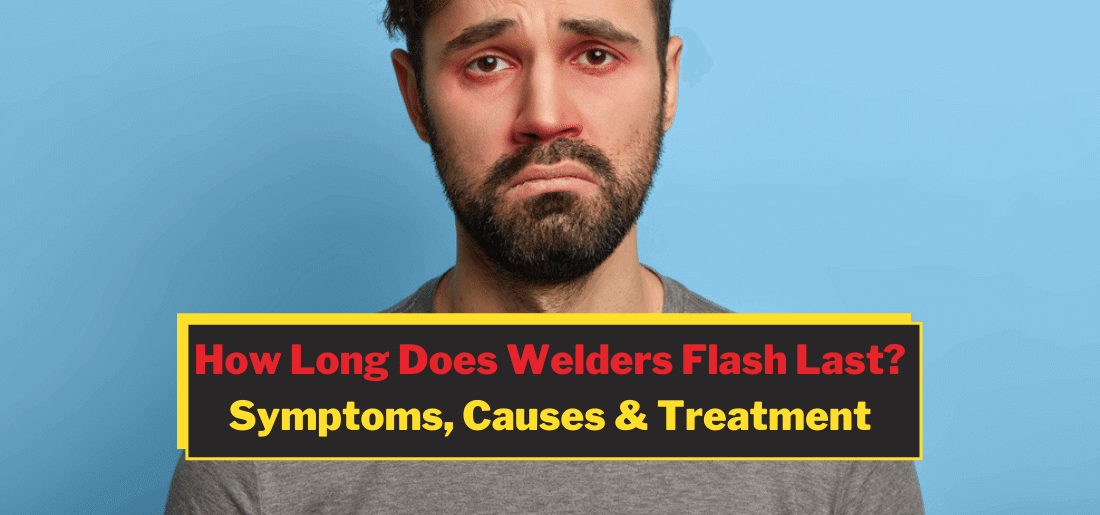We all are aware that welding is very dangerous and it is essential to wear all the necessary protective gear on the job without which you will be placing yourself at high risk. It is paramount to protect your body, and especially the face when the heat starts to grow intense and sparks fly.
Flying sparks can be extremely dangerous for the eyes and can cause serious damage to the eyes which can even result in blindness. Hence, welding tasks have to be performed with all the personal protection gear on.
Although sometimes, even if you take all the advised precautionary measures you still might experience a welder’s flash.
A welder’s flash is an instant bright flash of light during welding and leaves the affected individual with a vision issue. Fortunately, a welder’s flash lasts only for one to four days and is medically-treatable.
In our article on how long do welders flash last, we will take you through all that you need to know about a welder’s flash, common symptoms, and treatment options.
How Does a Flash Burn Occur? Symptoms & Causes
Before we learn how long does welders flash last, we need to know how exactly it occurs.
A flash burn occurs when and if the eyes are exposed to a very bright flash of light or extremely bright ultraviolet light. Ultraviolet light rays are harmful to the skin and the eyes.
However, in a case where the eyes are exposed to the rays, it causes a flash burn also called welders flash. Ultraviolet from any source can cause a flash burn, although it is still mostly associated with welding torches. Hence, the popular term “welder’s flash.”
What Does the Welder Flash Do to the Cornea?
When an individual experiences a welder’s flash, it’s very to a sunburn. In this case, instead of the skin, it’s to the eyes. Interestingly, it can affect both or just one eye. When a welder’s flash occurs it burns the cornea in your eye and can cause redness, irritation along with turning the eyes into bloodshot.
Most of the time, the cornea self-repairs itself in a few days, without leaving any scars. However, self-repairment is only successful when there is no added eye-strain and proper time is given to the healing process.
On the other hand, if the welder’s flash is not treated or constant strain is placed on the eyes, there is a high possibility that the affected eye can develop an infection.
Eye infections can be very serious that could lead to vision loss, especially if not medically-treated by a professional immediately.
Symptoms and Causes of Welders Flash Burn
Causes: The cause behind a welder’s flash is when the eye is exposed to heat and a bright flash of UV light. Although, the source of which could be different like a welding torch, sunlamp, halogen lamp, or flood lamp.
Symptoms: The most common symptoms of a welding flash burn are:
- Watery eyes
- Light sensitivity
- Blurred vision
- Eye irritation
- Severe to mild pain
What Does Welders Flash Feel Like?
After exposure, symptoms begin to appear immediately. Most of the time, the symptoms instantly appear after the eyes are exposed to the UV rays. One of the first signs is the feeling of instant eye-pain along with the twitching of the eyelids followed by swelling. The eyes also may turn bloodshot and may feel watery. In some cases, the skin around the eyelids becomes swollen and reddish.
Sometimes, the eyesight is also affected, while haziness and cloudiness may be experienced as they are some of the most common first symptoms of a welder’s flash. These symptoms might be experienced depending on how long does a welder’s flash last.
However, the problem with these symptoms from a diagnostic perspective is that these are not only exclusive to just a flash burn.
Hence, it is essential to know that the symptoms are because the affected individual was exposed to intense UV light from welding torches, sunlamps, directly starring at the sun, or halogen photography light.
Causes of Flash Burn
Direct exposure to intense ultraviolet rays is the cause of a flash burn. Most individuals suffer from it is because of their negligence to wear the necessary eye-protection equipment when they are working at a job that releases ultraviolet rays in an intense high amount. Apart from welding torches and ultraviolet rays, some other sources which can lead to a welder’s flash are:
- Directly looking at the sun for a while.
- Sunlamps at tanning spas.
- Flood and halogen lamps.
To avoid a welder’s flash staring directly at the above-mentioned sources is recommended. Most importantly, if an individual work’s in a welding industry or might know someone who works there, they should at all costs wear protective eye gear.
It’s always recommended and part of their work-apparel and there are eye goggles that are specifically manufactured for this type of work which you can purchase at a very budget-friendly cost.
What Happens When One Accidentally Looks at a Welding Arc?
The chances of coming in contact with a welding arc that doesn’t work in the welding industry are quite rare. However, the individuals who do work in the welding industry are at higher risk of being exposed to welding torches. Although, if an individual who is exposed to a welding arc by accident will experience a welder’s flash because of the absence of personal protective equipment.
If that happens, then the individual will suffer from the below-mentioned symptoms:
- Constant watery eyes.
- Feeling pressure in the affected eye.
- Bloodshot eyes.
- Redness around the eyelid.
- Swollen eyes.
- Intense to mild in the eyes.
- The feeling of something in the eyes.
- The inability to look at all types of light sources.
- Heightened light sensitivity.
Now the severity of a flash burn depends on a few factors like how far the individual was from the ultraviolet source, how long the eyes were exposed to the light source, and at what the angle was when the light source was looked at. These factors will determine how long does the welders flash last.
Moreover, people who work constantly with welder’s torch should be aware that this type of continuous exposure can develop cataracts which can result in the loss of their vision. Hence, we can’t stress enough the importance of personal protective gear for the eyes.
Diagnosis of Flash Burn
One of the most common diagnostic tests for anyone suffering from a welders flash is the “slit lamp test.” It is performed by medical professionals who carefully inspect and check the eyes using a microscope to look for any damage caused to the eyes.
Sometimes, an orange dye with a special blue light might be used in the diagnosis to understand the severity of the damage caused to the cornea.
The orange dye is completely harmless and it shouldn’t be a cause of concern because it can be washed away by water and sometimes by watery eyes.
There’s also another test that is performed too, which is called the “visual acuity test” in which the medical professional inspects the movement of the eyes and the vision of the individual suffering from the flash burn.
To sum it up a welder’s flash diagnosis tests include the following:
- The usage of a microscope of the damaged eyes.
- An anesthetic drop is used to numb the affected eyes.
- The usage of an orange dye to understand the damage of the cornea.
- Blue light is used after the orange dye.
Treatment for Flash Burn
Some very effective treatments can help heal a flash burn. However, it should be noted that apart from the treatments one of the best practices is giving your eyes ample rest to heal in the best possible manner. The time taken out for relaxation will determine how long does the welders flash last, the more time an individual takes out the more speedy the recovery will be.
Now let’s look at some of the treatments recommended for a flash burn:
Dressing:
Eye-dressing is the best way to help the eyes rest and heal. The affected-eye needs to be covered with padded-dressing to protect from unnecessary light exposure and eye-rubbing because some of the common symptoms of a flash burn are eye irritation that leads to the feeling of constant eye rubbing which can slow-down the healing process.
Applying Cool Packs:
Cool packs are very effective in providing symptomatic relief and can be placed over the affected-eye over the dressing as they will also help in reducing the swelling. A cool pack should be used in moderation like 3 to 4 times a day and not more.
Dilating Drops:
The usage of dilating drops is recommended to relax the eye muscles as it helps in easing the constant pain and also gives the affected eye time to rest and heal properly. However, some of the effects of dilating drops are that the pupils might appear bigger than normal and the effect can last a few hours or days.
Antibiotics:
A medical professional may prescribe the use of antibiotic ointment or drops to be used at home which will help in reducing the development of an eye infection. It is highly advised to follow all advice given by the medical professional on how many times the antibiotic-medicine should be used and driving may be advised against by the doctor as well.
In some cases, the doctor may also recommend a mild anti-inflammatory steroid-based drop too. Moreover, an artificial tear drop ointment may be prescribed too to help relieve some of the symptoms. All in all, the medical-professionals prescription should be trusted and followed for faster recovery and healing of the affected eye.
Reviewal:
The medical-professional will ask you to come for a checkup after 24 to 48 hours to ensure that the eyes have started to heal and to make sure that an infection doesn’t develop. Therefore, it’s very important to stay go for the checkup as asked by the medical-professional because the treatment plan may have to change if the eyes don’t begin to heal immediately after the recommended prescribed medication and rest.
In case of any serious issue, an opthalmologist may have to be visited and the placement of a bandage contact lens of the affected eye will be recommended by the professional for faster and improved healing. Therefore, the reviewal checkup is very important and shouldn’t be missed even if the affected individual feels the eye is healing.
Prevention of Welders Flash
In some cases, as we discussed before, a welders flash can occur through other light sources. However, individuals who are working in the welding industry can take the following preventive measures to protect their eyes as prevention is the best method for it:
- Purchasing eye google that is made as per Health and Safety standards and completely covers the eyes.
- To protect the cornea from ultraviolet rays, coated safety eye goggles should be worn along with a welder’s mask when on a welding site or about to perform a welding-job.
- If an individual is wearing sunglasses to prevent a flash burn, the sunglasses should be able to protect them from UVB and UV radiation. When buying sunglasses the labels should be checked to understand the protection it provides to the eyes.
Conclusion
To sum it up, a welder’s flash occurs when the eyes are exposed to intense ultraviolet light and can be quite painful. It is mostly experienced by welder’s as their work revolves around working with machinery that emits ultraviolet light. In most cases, a welder’s flash is treatable and heals over time. Nonetheless, personal protective eye gear is essential for all welders when working on site. We hope that our article on how long does welders flash last was helpful and we were able to help you give all the information you needed.




